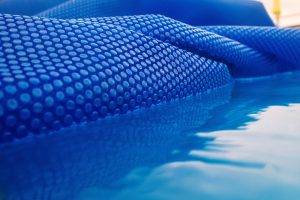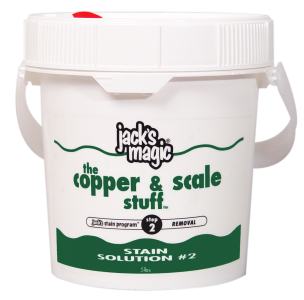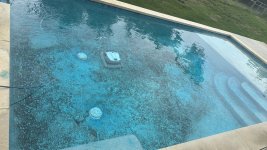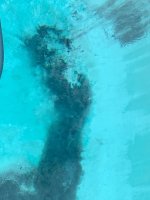Hi, I am prepping my pool for closure and shocked yesterday. Shortly after, these black stains appeared. It’s been over 24 hours and they are still there. I recall this happened, not as badly, last time I had to use shock at opening but it went away within a day. Any suggestions? Thanks!
Black Stains After Shocking Before Closing
- Thread starter Nealkaiser
- Start date
You are using an out of date browser. It may not display this or other websites correctly.
You should upgrade or use an alternative browser.
You should upgrade or use an alternative browser.
- Jul 21, 2013
- 65,118
- Pool Size
- 35000
- Surface
- Plaster
- Chlorine
- Salt Water Generator
- SWG Type
- Pentair Intellichlor IC-60
Looks like copper stains.
What chemicals have you been using this season?
 www.troublefreepool.com
www.troublefreepool.com
What chemicals have you been using this season?
Copper in Pool Water - Further Reading
It’s a SWG. I balanced using PoolMath in the beginning of the season and maintained. Only uses some calcium and stabilizer this year from what I recall. I did have to get a new heater. The stains are only in the deep end where I dumped the shock packets.
- Jun 1, 2018
- 16,012
- Pool Size
- 26000
- Surface
- Vinyl
- Chlorine
- Salt Water Generator
- SWG Type
- Hayward Aqua Rite (T-15)
- Jul 21, 2013
- 65,118
- Pool Size
- 35000
- Surface
- Plaster
- Chlorine
- Salt Water Generator
- SWG Type
- Pentair Intellichlor IC-60
Why did you need to get a new heater?
What happened to your old heater?
What happened to your old heater?
Thanks. I was using HTC Pool Shock Advanced packets. The old heater was about 8 years old and the burner was really rusted/corroded.
If the black stains came at the time of shocking, would it be something in the shock itself, or somehow that changed the chemistry to bring out the copper stains that were previously not showing? Thanks.
If the black stains came at the time of shocking, would it be something in the shock itself, or somehow that changed the chemistry to bring out the copper stains that were previously not showing? Thanks.
- Jul 21, 2013
- 65,118
- Pool Size
- 35000
- Surface
- Plaster
- Chlorine
- Salt Water Generator
- SWG Type
- Pentair Intellichlor IC-60
“Shocking” causes temporary rise in the pH that can cause metals in the pool water to deposit on the surfaces. That localized pH rise is why the stains appeared where you dropped the shock.
Sometimes the metals lift and go back into solution once the pH drops down.
TFP methods do not shock pools.

 www.troublefreepool.com
www.troublefreepool.com
Sometimes the metals lift and go back into solution once the pH drops down.
TFP methods do not shock pools.

Pool Care Basics Archives
Your one-stop shop for all things TFP to include: ABCs of Water Chemistry, Recommended Chemicals/Levels, Test Kits, Troubleshooting, and much more!
- Jul 21, 2013
- 65,118
- Pool Size
- 35000
- Surface
- Plaster
- Chlorine
- Salt Water Generator
- SWG Type
- Pentair Intellichlor IC-60
- Aug 20, 2020
- 7,766
- Pool Size
- 27000
- Surface
- Plaster
- Chlorine
- Salt Water Generator
- SWG Type
- CircuPool RJ-60
The packets look like cal-hypo?Thanks. I was using HTC Pool Shock Advanced packets. The old heater was about 8 years old and the burner was really rusted/corroded.
If the black stains came at the time of shocking, would it be something in the shock itself, or somehow that changed the chemistry to bring out the copper stains that were previously not showing? Thanks.
Thanks. I will look into the PH levels later today. I appreciate everyone's advice!
Almost definitely copper stains.
The turquoise color is one type of copper stain and the black is a different type.
The black is probably Copper (II) Oxide or cupric oxide, which is black.
The calcium hypochlorite oxidizes the copper and changes the compound.

Here you can see how calcium hypochlorite makes a black copper stain.
They use aluminum sulfate to remove the stain, but I have never heard of that being used before, so I do not know how well it works.
It seems to work in the video.
Other possible stain removers are sulfamic acid, ascorbic acid, oxalic acid and citric acid.
Some might work, some might do nothing and some might make things worse.
Below is a video showing aluminum sulfate being used to remove the stains.
This might be the reaction of aluminum sulfate and the copper (II) Oxide.
Al2(SO4)3 + 3CuO --> Al2O3 + 3CuSO4
Aluminum sulfate + Copper (II) oxide --> Aluminum oxide + Copper sulfate.
Aluminum oxide is usually white, so, if the copper oxide is becoming aluminum oxide, it might be a white stain, which will be ok for a white pool but it might be bad for a darker color plaster.
Darker plaster usually hides copper stains as long as the stains match the plaster color.
Some plaster is a turquoise, blue or green and that hides turquoise copper stains.
Darker grey or black plaster can hide grey or black copper stains.
Using aluminum sulfate on dark plaster might leave a white stain that looks worse than the darker stain.
The turquoise color is one type of copper stain and the black is a different type.
The black is probably Copper (II) Oxide or cupric oxide, which is black.
The calcium hypochlorite oxidizes the copper and changes the compound.
Here you can see how calcium hypochlorite makes a black copper stain.
They use aluminum sulfate to remove the stain, but I have never heard of that being used before, so I do not know how well it works.
It seems to work in the video.
Other possible stain removers are sulfamic acid, ascorbic acid, oxalic acid and citric acid.
Some might work, some might do nothing and some might make things worse.
Below is a video showing aluminum sulfate being used to remove the stains.
This might be the reaction of aluminum sulfate and the copper (II) Oxide.
Al2(SO4)3 + 3CuO --> Al2O3 + 3CuSO4
Aluminum sulfate + Copper (II) oxide --> Aluminum oxide + Copper sulfate.
Aluminum oxide is usually white, so, if the copper oxide is becoming aluminum oxide, it might be a white stain, which will be ok for a white pool but it might be bad for a darker color plaster.
Darker plaster usually hides copper stains as long as the stains match the plaster color.
Some plaster is a turquoise, blue or green and that hides turquoise copper stains.
Darker grey or black plaster can hide grey or black copper stains.
Using aluminum sulfate on dark plaster might leave a white stain that looks worse than the darker stain.
Note that any procedures have costs and risks.
Do your own research to make sure that you understand the costs and risks.
I recommend a local professional to help you figure out the best solution for you.
Everything is at your own risk based on your own research and your own decisions.
I would try Jack's #2 (Sulfamic acid) followed by a drain and refill if it is safe to drain.
You can do a light acid wash after, but it is better to avoid acid washing because it damages the plaster.
Plaster is made of cement and aggregate.
An acid wash will dissolve the cement and expose the aggregate.
If the aggregate is quartz sand, the surface will be like sandpaper.
If the aggregate is pebble, the surface will be like exposed aggregate concrete.
There are different types of pebble from small and smooth to big and rough.
Some people find it objectionable and some people are not as bothered by it.
I would avoid an acid wash if possible especially if the surface is now smooth.
I would try sulfamic acid first and then a no drain acid wash before doing a drain and acid wash.
Even if the sulfamic acid only gets 50% of the stains, it will reduce the amount of acid required for the acid wash.
Don't allow the sulfamic acid to circulate through the system.
Metal items in the water, like lights, rails and light niches can possibly be damaged by sulfamic acid or a zero alkalinity treatment (no drain acid wash), so rails should be removed and lights can be pulled out and put on the deck during treatment, but niches can't be moved.
In the below case, they opted for a drain and acid wash, but that causes a lot of cement in the plaster to dissolve, which damages the plaster.
The people were happy with the appearance, but they never reported on the damage to the plaster or if it got really rough.
 www.troublefreepool.com
www.troublefreepool.com
 jacksmagic.com
jacksmagic.com








Note that any procedures have costs and risks.
Do your own research to make sure that you understand the costs and risks.
I recommend a local professional to help you figure out the best solution for you.
Do your own research to make sure that you understand the costs and risks.
I recommend a local professional to help you figure out the best solution for you.
Everything is at your own risk based on your own research and your own decisions.
I would try Jack's #2 (Sulfamic acid) followed by a drain and refill if it is safe to drain.
You can do a light acid wash after, but it is better to avoid acid washing because it damages the plaster.
Plaster is made of cement and aggregate.
An acid wash will dissolve the cement and expose the aggregate.
If the aggregate is quartz sand, the surface will be like sandpaper.
If the aggregate is pebble, the surface will be like exposed aggregate concrete.
There are different types of pebble from small and smooth to big and rough.
Some people find it objectionable and some people are not as bothered by it.
I would avoid an acid wash if possible especially if the surface is now smooth.
I would try sulfamic acid first and then a no drain acid wash before doing a drain and acid wash.
Even if the sulfamic acid only gets 50% of the stains, it will reduce the amount of acid required for the acid wash.
Don't allow the sulfamic acid to circulate through the system.
Metal items in the water, like lights, rails and light niches can possibly be damaged by sulfamic acid or a zero alkalinity treatment (no drain acid wash), so rails should be removed and lights can be pulled out and put on the deck during treatment, but niches can't be moved.
In the below case, they opted for a drain and acid wash, but that causes a lot of cement in the plaster to dissolve, which damages the plaster.
The people were happy with the appearance, but they never reported on the damage to the plaster or if it got really rough.
Two-Year-Old Pool Major Discoloration and Bleaching
Hi, Everyone! New to the forum and to pools in general. Closed on a house with my first pool! Yay! Although it's only two years old it has major discoloration (light and dark spots). General home inspector thought it was algae but the water is so clear. Here is what the prior owners...
STAIN SOLUTION #2 – The Copper & Scale Stuff | Jacks Magic


Note that any procedures have costs and risks.
Do your own research to make sure that you understand the costs and risks.
I recommend a local professional to help you figure out the best solution for you.
Last edited:
Thread Status
Hello , This thread has been inactive for over 60 days. New postings here are unlikely to be seen or responded to by other members. For better visibility, consider Starting A New Thread.


